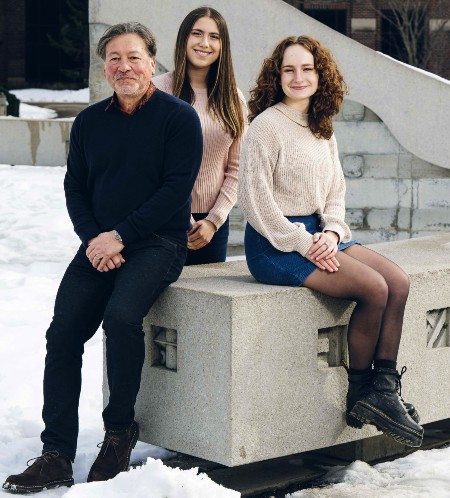Built Environment Plays a Role in Mitigating Disease

From left: Julio Ramirez, Raquel Ruiz and Julia Olson
Examining how the pandemic affected operations in meatpacking plants may lead to infrastructure changes
In the early months of the COVID-19 pandemic, many businesses migrated to remote work or paused operations entirely unless their services were deemed essential. Meatpacking plants, an essential link in the grocery supply chain, remained in operation. With workers standing in close proximity to one another for long hours often in messy conditions, the industry was among the hardest hit by COVID-19 in terms of infection and mortality rates.
“With so many people indoors, sharing the same space, the built environment played a significant role in the spread of COVID-19,” said Julia Olson, an undergraduate research assistant who interviewed the leadership of a local meatpacking plant. “We’re looking at changes that could be made to the infrastructure in a general sense as well as this particular plant and its workflow to help reduce the spread of disease.”
Olson, a junior in civil engineering from Chaska, Minnesota, is working with Julio Ramirez, the Karl H. Kettelhut Professor in Civil Engineering and director of the Natural Hazards Engineering Research Infrastructure Center-Network Coordination Office. Ramirez is co-principal investigator on a study of joint hazard mitigation in the era of COVID-19. The multi-disciplinary study involves engineers and social scientists from Purdue, Rensselaer Polytechnic Institute, Georgia State University and the University of Notre Dame and is funded under a grant from the National Science Foundation awarded in August 2020.
The Purdue team’s component of the project focuses on the impact COVID-19 had on the workflow within several types of environments, including schools, health care facilities and meatpacking plants. While Olson focuses on meatpacking plants, master’s student Raquel Ruiz, another member of the research team, is working with a psychiatric unit in the Chicago area to collect information about a specific aspect of the health care industry.
“Much emphasis during the response to the ongoing COVID-19 pandemic has rightly been on traditional public health efforts to control it; however, less prominent but no less vital is the role of the built environment itself in both amplifying and suppressing the spread of COVID-19,” Ramirez said. “We must examine things from a multi-disciplinary perspective because there are lessons to be learned from temporary and permanent changes made due to the pandemic that will influence the future of infrastructure.”
Implementing recommended precautions — such as maintaining six feet between another person or wearing masks — was challenging in meatpacking plants where workers often stand shoulder to shoulder wearing fluid-soaked masks. Through her research, Olson learned how plant operations and processes were affected by the pandemic.
“In some cases, larger plants in the area were forced to shut down due to outbreaks,” Olson said. “That meant the smaller plants had to increase production in order to meet supply chain demands. Smaller operators felt trapped in the system.”
Identifying flexibility within systematic workflow is key to reducing disease spread. Ramirez points to the large number of jobs that transitioned to telework in 2020 — approximately 72% of individuals in white-collar jobs were working remotely according to Gallup (2021) — as an example of flexibility within workflow. For many, their residence became their office and sometimes, a classroom for their children, almost overnight. But for most blue-collar jobs, remote work is not an option.
“In the meatpacking plants, we see this division of flexibility of workflow,” Ramirez said. “Some administrative positions, such as finance or human resources employees can work remotely. But the process of preparing the meat, packaging it and shipping it, the job cannot be done unless a worker is physically there. That’s why we need to look at changes to the infrastructure so we can be proactive in advance of the next pandemic, rather than reactive.
“There were some industries, such as health care, that had planned and prepared for such an eventuality and yet the system is still strained because none of the infrastructure was designed to withstand a pandemic of this magnitude. We are looking at precisely what transitions took place to allow industries to continue to operate and how successful they were. Reacting to the pandemic has been a very painful adjustment, emotionally, physically and economically. Everyone managed the best they could, but there is much to learn.”
Contributing to the research project has further cemented Olson’s passion for civil engineering and developed her empathy for others, a leadership trait that the ROTC midshipman will espouse as a Naval officer.
“It’s really eye-opening to hear first-hand how difficult navigating the pandemic has been for these business owners,” Olson said. “As engineers, we must consider the human factor. Working on this research project helped develop my critical thinking skills. Understanding the issues faced in meatpacking plants helps us to form conclusions and consider how proposed changes to infrastructure might impact people.”
